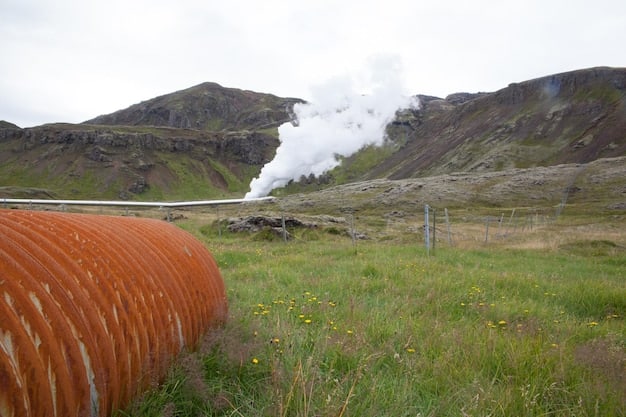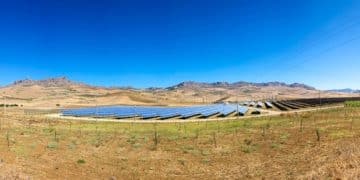Geothermal Energy in the US: Powering Homes and Businesses with Underground Heat

Geothermal energy in the US harnesses the Earth’s internal heat to sustainably power homes and businesses, offering a reliable and eco-friendly alternative to traditional energy sources while reducing carbon emissions and dependence on fossil fuels.
Harnessing the Earth’s internal heat offers a sustainable and reliable energy source which can revolutionize the way we power our lives. Geothermal energy in the US: Unlocking the Potential of Underground Heat to Power Homes and Businesses represents a significant opportunity to reduce our carbon footprint and transition to a more sustainable energy future.
Understanding Geothermal Energy: A Natural Power Source
Geothermal energy, derived from the Earth’s internal heat, presents a compelling alternative to fossil fuels. This natural energy source offers a sustainable and consistent power supply, making it an attractive option for regions with geothermal resources.
What is Geothermal Energy?
Geothermal energy is heat derived from the Earth’s interior. This heat, constantly produced inside the Earth, can be harnessed for various applications, including electricity generation and direct use for heating and cooling.
How Does Geothermal Energy Work?
Harnessing geothermal energy involves tapping into underground reservoirs of hot water and steam. These resources are brought to the surface through wells, and the steam is used to turn turbines, generating electricity. Alternatively, the hot water can be directly used for heating purposes.
- Geothermal Power Plants: Use steam from geothermal reservoirs to power turbines and generate electricity.
- Geothermal Heat Pumps: Utilize the Earth’s constant temperature to heat and cool buildings efficiently.
- Direct Use Applications: Employ geothermal heat for various purposes like greenhouse heating, aquaculture, and industrial processes.
Geothermal energy’s consistent availability and low environmental impact position it as a vital component of a sustainable energy mix, offering a reliable alternative to conventional energy sources.
Geothermal Energy Resources in the US: A Vast Untapped Potential
The United States possesses significant geothermal resources, primarily concentrated in the western states. These resources offer the potential to substantially contribute to the nation’s energy needs.

Geographic Distribution of Geothermal Resources
Geothermal resources are not evenly distributed across the US. The western states, particularly California, Nevada, Utah, and Oregon, boast the most substantial geothermal reservoirs due to their geological characteristics and volcanic activity.
Types of Geothermal Resources
The US is home to various types of geothermal resources, each with its unique potential for energy production. These include hydrothermal resources (steam and hot water), enhanced geothermal systems (EGS), and low-temperature geothermal resources.
The abundance and diversity of geothermal resources in the US offer a significant opportunity to expand the nation’s renewable energy capacity and reduce reliance on fossil fuels.
Current Geothermal Energy Production in the US: A Snapshot
While geothermal energy holds immense potential, its current contribution to the US energy mix remains relatively modest. However, ongoing technological advancements and supportive policies are driving growth in the sector.
Despite its potential, geothermal energy currently accounts for less than 1% of the total electricity generation in the United States. The Geysers in California is the largest geothermal power plant in the world.
- Electricity Generation: Geothermal power plants generate clean electricity, primarily in western states.
- Direct Use Applications: Geothermal energy is increasingly used for heating and cooling buildings, as well as for various industrial and agricultural processes.
- Capacity Expansion: Efforts are underway to develop new geothermal projects and expand the capacity of existing plants.
Increasing geothermal energy production in the US requires continued investment in research, development, and deployment of advanced technologies, as well as supportive government policies and incentives.
The Benefits of Geothermal Energy: A Sustainable Choice
Geothermal energy offers numerous environmental and economic benefits, making it a compelling option for a sustainable energy future. Its reliability, low emissions, and potential for job creation make it an attractive alternative to fossil fuels.

One of the primary advantages of geothermal energy is its minimal environmental impact compared to fossil fuels. Geothermal power plants produce significantly lower emissions of greenhouse gases and air pollutants.
- Renewability: Geothermal energy is a renewable resource replenished by the Earth’s natural processes.
- Reliability: Unlike solar and wind, geothermal energy is consistently available, providing a stable and predictable power supply.
- Low Emissions: Geothermal power plants produce minimal greenhouse gas emissions compared to fossil fuel-based power plants.
Economic Advantages
Investing in geothermal energy can create new economic opportunities, stimulate job growth, and reduce dependence on imported fuels. Moreover, geothermal projects can provide long-term economic benefits to local communities.
Challenges and Opportunities in Geothermal Energy Development
Despite its many advantages, geothermal energy development faces several challenges, including high upfront costs, technological barriers, and regulatory hurdles. Addressing these challenges is crucial to unlocking the full potential of geothermal resources.
One of the primary challenges is the high initial capital investment required to build geothermal power plants and develop geothermal resources. Drilling wells, constructing power plants, and installing transmission infrastructure can be expensive.
Overcoming Barriers
To overcome these challenges, it is essential to foster innovation, streamline regulatory processes, and provide financial incentives for geothermal projects. Additionally, raising public awareness about the benefits of geothermal energy can help garner support for its development.
- Technological Advancements: Developing advanced drilling techniques, enhanced geothermal systems (EGS), and other innovative technologies can reduce costs and improve efficiency.
- Policy Support: Implementing supportive policies, such as tax credits, grants, and loan guarantees, can incentivize investment in geothermal projects.
- Public Awareness: Educating the public about the benefits of geothermal energy can help build support for its development and deployment.
The Future of Geothermal Energy in the US: A Promising Outlook
The future of geothermal energy in the US looks promising, with increasing recognition of its potential to contribute to a clean and sustainable energy future. Ongoing research, technological advancements, and supportive policies are paving the way for greater geothermal energy development.
As the US transitions to a low-carbon economy, geothermal energy is poised to play an increasingly important role. Its reliability, low emissions, and potential for job creation make it an attractive option for meeting the nation’s energy needs.
- Enhanced Geothermal Systems (EGS): EGS technology has the potential to unlock vast geothermal resources in areas not traditionally suitable for geothermal development.
- Hybrid Renewable Energy Systems: Combining geothermal energy with other renewable energy sources, such as solar and wind, can create resilient and reliable energy systems.
- Community Geothermal Projects: Developing community-scale geothermal projects can provide affordable and sustainable energy to local communities.
By investing in geothermal energy research, development, and deployment, the US can harness its vast underground heat resources, reduce its carbon footprint, and create a more sustainable energy future for all.
| Key Point | Brief Description |
|---|---|
| 🔥 Sustainable Energy | Geothermal energy offers a renewable and reliable power source. |
| 🌎 US Resources | The US has vast geothermal resources, mainly in the western states. |
| ✅ Environmental Benefits | Geothermal energy produces low emissions, reducing environmental impact. |
| 💰 Economic Growth | Geothermal projects can create jobs and stimulate local economies. |
Frequently Asked Questions
▼
Geothermal energy works by tapping into the Earth’s internal heat. Hot water or steam is extracted from underground reservoirs to generate electricity or provide direct heating for buildings and industrial processes.
▼
The primary geothermal resources in the US are located in the western states, including California, Nevada, Oregon, and Utah. These regions have significant hydrothermal and enhanced geothermal systems.
▼
Geothermal energy offers numerous environmental benefits, including low greenhouse gas emissions, reduced air pollution, and minimal land use compared to fossil fuel-based power plants. It is also a renewable resource.
▼
Challenges in geothermal energy development include high upfront costs, technological barriers in accessing deep geothermal resources, and regulatory hurdles. Investment and innovation are crucial to overcome these challenges.
▼
The future outlook for geothermal energy in the US is promising, with increasing recognition of its potential to contribute to a clean and sustainable energy future. Ongoing research and policy support are driving growth in the sector.
Conclusion
Geothermal energy in the US: Unlocking the Potential of Underground Heat to Power Homes and Businesses represents a significant opportunity to transition to a sustainable energy future. While challenges exist, the environmental and economic benefits of geothermal energy make it a compelling option for reducing our carbon footprint and creating a cleaner, more resilient energy system.





